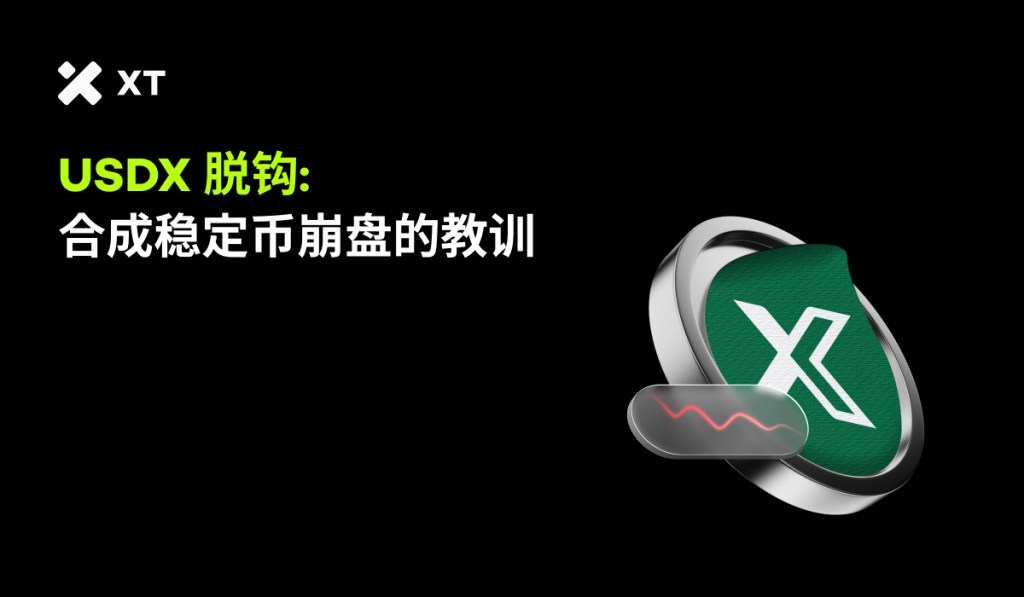Last week, the decentralized finance (DeFi) world was once again shaken by a severe decoupling event involving the synthetic stablecoin USDX issued by Stable Labs. On November 6, 2025, this token, which was supposed to maintain a 1:1 value with the US dollar, plummeted in price, briefly dropping to a low of $0.30. The event sent shockwaves throughout the DeFi ecosystem, raising new questions about the stability of synthetic assets, hidden risks in complex lending protocols, and potential contagion effects in interconnected markets. This article will explore the timeline of the USDX crash, delve into its underlying synthetic stablecoin mechanism, analyze the possible reasons for the decoupling, and examine its broader impact on the DeFi landscape.

Decoupling Analysis: What Happened to USDX?
The crisis unfolded rapidly on November 6. USDX, an asset that once had a circulating supply exceeding $680 million at its peak, began to lose its footing. Within hours, its value plummeted by over 60%, marking a catastrophic failure for an asset built on a promise of stability. The price drop triggered widespread alarm among users and integrated platforms.
Prominent DeFi protocols using USDX in their liquidity pools and lending markets were forced to react swiftly. As a major decentralized exchange (DEX) on the BNB Smart Chain, PancakeSwap issued a statement urging users to review and monitor their positions involving the USDX treasury, acknowledging the situation at hand.
Meanwhile, the on-chain lending protocol Lista DAO, which used USDX as collateral, found itself at the center of the crisis. The protocol observed abnormally high borrowing rates, reaching an astonishing 800% in certain treasuries, without seeing corresponding repayment activity from major borrowers. Reports indicated that these borrowers, associated with Stable Labs, were using USDX and its staked version sUSDX as collateral to borrow other stablecoins like USDC and USDT. This activity was effectively draining the platform's liquidity while accumulating unsustainable interest, indicating little intention to repay the loans.
In response, Lista DAO initiated an emergency governance vote (LIP 022) to trigger a forced liquidation of the affected USDX market. The proposal quickly passed among veLISTA token holders, aiming to adjust the oracle price of USDX to reflect its actual market value, thereby triggering public liquidations of under-collateralized positions. The goal was to minimize further losses and prevent a complete collapse of the lending pool. The treasury manager on Lista, Re7 Labs, proposed a liquidation plan, and the DAO executed a flash loan to liquidate over $3.5 million in USDX, recovering nearly $3 million in USD1 tokens in the process.
Despite these measures, the damage was done. Trust in USDX was shattered, and its value continued to remain far below the expected $1 peg, exposing the vulnerabilities in its design and the systemic risks it posed to the protocols that integrated it.
Understanding the Synthetic Stablecoin Mechanism
To understand why USDX failed so dramatically, it is essential to grasp what a synthetic stablecoin is and how it differs from other stablecoin models. Unlike fiat-collateralized stablecoins (like USDC or USDT) that are backed by actual dollars or equivalent asset reserves held by banks, synthetic stablecoins derive their value through complex on-chain financial engineering.
Specifically, USDX was designed to maintain its peg through a "delta-neutral" hedging strategy. This concept is relatively complex. Theoretically, Stable Labs would receive user deposits and use them to create positions that hedge against market price fluctuations. For example, they might hold a long position in a crypto asset (like Bitcoin or Ethereum) while simultaneously holding an equivalent short position. The goal is to ensure that any losses on one side of the trade are offset by gains on the other side, thereby creating a stable, or "delta-neutral," portfolio. The profits generated from these trading strategies would then be used to support the value of the issued stablecoin USDX.
This model is inherently more complex than a simple reserve-backed model and carries different risks. Its stability relies on several key assumptions:
- Effective Hedging: The delta-neutral strategy must be perfectly managed. Any failure to maintain the hedge could expose the collateral to market volatility.
- Sufficient Liquidity: The market must have enough liquidity for the strategy to be executed effectively, and redemptions can be processed without causing price slippage.
- Active Management: The collateral portfolio requires continuous monitoring and rebalancing to adapt to changing market conditions.
- Oracle Integrity: The system relies on reliable price information sources (oracles) to value its collateral and trigger liquidations correctly.
When these assumptions are broken, the entire structure can quickly become unstable. The strength of a synthetic stablecoin depends on its underlying mechanisms and the diligence of its managers. The USDX decoupling event serves as a stark reminder that promises of stable value derived from complex algorithms and trading strategies can be extremely fragile.
Exploring the Causes of the Crash
While Stable Labs remained silent immediately following the event, on-chain analysts and community members pieced together a compelling narrative regarding the possible causes. The crash appears to have been triggered by a combination of external shocks, suspicious internal operations, and inherent flaws in the stablecoin's design.
The Ripple Effect of the Balancer Hack
One mainstream theory points to the aftermath of a significant security breach. Just days before the decoupling event, on November 3, the DeFi protocol Balancer suffered a massive attack, resulting in approximately $128 million in losses. Some analysts believe that Stable Labs had hedged positions on Balancer or related platforms. This attack may have triggered a series of forced liquidations of Stable Labs' BTC and ETH short positions.
If the protocol's hedge was suddenly closed at a loss, the value of the collateral supporting USDX would be severely compromised. This could trigger a wave of user redemptions driven by concerns over the stablecoin's solvency. A sudden bank run would place immense pressure on the remaining collateral, creating a typical bank run scenario and leading to the decoupling.
Poor Portfolio Management and Suspicious Collateral
Further investigation raised serious questions about Stable Labs' management of its collateral portfolio. A researcher from the digital asset management firm Hyperithm pointed out that the composition of USDX's portfolio had not been updated for over two months. For a strategy that requires constant adjustments to maintain an effective delta-neutral position, this lack of active management is a significant red flag.
Even more concerning was the discovery of unusual and illiquid assets, such as "BANANA31," within the portfolio. Holding such assets contradicts the principles of a stable, delta-neutral fund and indicates poor risk management. A portfolio exposed to market volatility without rebalancing is a ticking time bomb, and the lack of rebalancing may have made USDX susceptible to the very volatility it was supposed to neutralize.
Draining Liquidity and Suspicious Borrowing Activity
Perhaps the most compelling evidence comes from on-chain data tracking wallet activity allegedly linked to Stable Labs founder Flex Yang. In the days leading up to the crash, this wallet was observed depositing USDX and sUSDX as collateral on lending platforms like Lista, Euler, and Silo. It then borrowed other more reliable stablecoins, such as USDC and USDT, using these collateral assets.
This activity is highly suspicious for two reasons. First, it systematically drained liquidity of high-quality stablecoins from these platforms, replacing them with the less reputable USDX. Second, the borrowers were willing to pay annualized interest rates as high as 800% with no apparent intention to repay. This behavior strongly suggests a deliberate strategy to extract as much real value from the ecosystem as possible before the inevitable crash of USDX. For many observers, this appeared more like a well-planned exit than a market failure, leaving the mess for lending protocols and their users.
Chain Reaction: Connections to Other Failure Events
The DeFi space is a network of interconnected protocols, where instability in one project can quickly spread to others. The USDX crisis occurred in the shadow of another recent crash event. Another DeFi protocol, Stream Finance, paused its operations on November 4 due to a $93 million hack. Its own stablecoin, xUSD, had already decoupled and collapsed. Notably, the collateral used in the troubled USDX treasury on Lista DAO was similar to the assets involved in the Stream Finance failure, highlighting a pattern of contagion spreading through high-risk cross-collateralized financial products in the ecosystem.
The protocol Elixir, which issues its own stablecoin deUSD, announced that it would stop supporting the token after the Stream Finance hack event due to significant exposure to that incident. This domino effect illustrates how the failure of one asset can trigger a crisis of confidence, dragging down neighboring projects.
Broader Implications for the DeFi Ecosystem
The USDX decoupling event is not just an isolated incident; it serves as a cautionary tale with far-reaching implications for the broader DeFi space.
First, it dealt another blow to the reputation of synthetic and algorithmic stablecoins. Following the multi-billion dollar collapse of Terra-Luna in 2022, the market has understandably remained wary of stablecoins that are not fully backed by transparent off-chain reserves. The failure of USDX, a project that had touted compliance with MiCA regulations and was well-funded, reinforced the perception that these models are inherently risky and complex. It underscored the difficulties of maintaining a peg through algorithms and active trading, especially during periods of market stress.
Second, the event highlighted the dangers of cross-protocol integration and systemic risk. When protocols like PancakeSwap and Lista DAO integrated USDX into their systems, they also inherited its risks. This crisis forced these platforms into emergency mode, eroding user trust and potentially causing financial losses for liquidity providers and lenders. This serves as a crucial lesson for DeFi protocols: they must conduct rigorous due diligence on the assets they integrate and diversify their collateral to avoid single points of failure.
Third, it placed the actions of project founders and teams under close scrutiny. Allegations of a wallet associated with the founder of Stable Labs deliberately draining liquidity have raised serious ethical and potentially legal issues. If true, such behavior would poison the well of trust upon which the entire DeFi ecosystem relies. It shifts the discussion from market risk to counterparty risk, even in an environment that is supposed to be "trustless."
Finally, the event has sparked a renewed call for better risk management tools and more robust governance mechanisms. Lista DAO acted swiftly to initiate a forced liquidation vote, demonstrating the importance of establishing emergency procedures. However, the rapid deterioration of the situation also indicates that current safeguards are not foolproof. Protocols may need to implement stricter collateral requirements, dynamic borrowing limits, and more complex real-time risk monitoring to protect themselves and their users from similar future events.
The story of the USDX crash is not unfamiliar in the turbulent world of cryptocurrency. It is a tale of ambitious financial engineering, opaque operations, and the devastating consequences that arise when trust is broken. While some speculative traders may profit from buying decoupled assets, the ultimate result is a loss of confidence and capital for the broader community. As the DeFi space matures, it must learn from these failures. Building a truly resilient and sustainable financial system requires more than just innovative code; it demands transparency, accountability, and a deep-rooted respect for risk.
About XT.COM
Founded in 2018, XT.COM is a leading global digital asset trading platform, now boasting over 12 million registered users, with operations covering more than 200 countries and regions, and an ecosystem traffic exceeding 40 million. The XT.COM cryptocurrency trading platform supports over 1,300 quality coins and 1,300 trading pairs, offering a variety of trading services including spot trading, margin trading, and futures trading, along with a secure and reliable RWA (Real World Assets) trading market. We adhere to the philosophy of "Exploring Crypto, Trusting Trading," committed to providing global users with a safe, efficient, and professional one-stop digital asset trading experience.
免责声明:本文章仅代表作者个人观点,不代表本平台的立场和观点。本文章仅供信息分享,不构成对任何人的任何投资建议。用户与作者之间的任何争议,与本平台无关。如网页中刊载的文章或图片涉及侵权,请提供相关的权利证明和身份证明发送邮件到support@aicoin.com,本平台相关工作人员将会进行核查。




